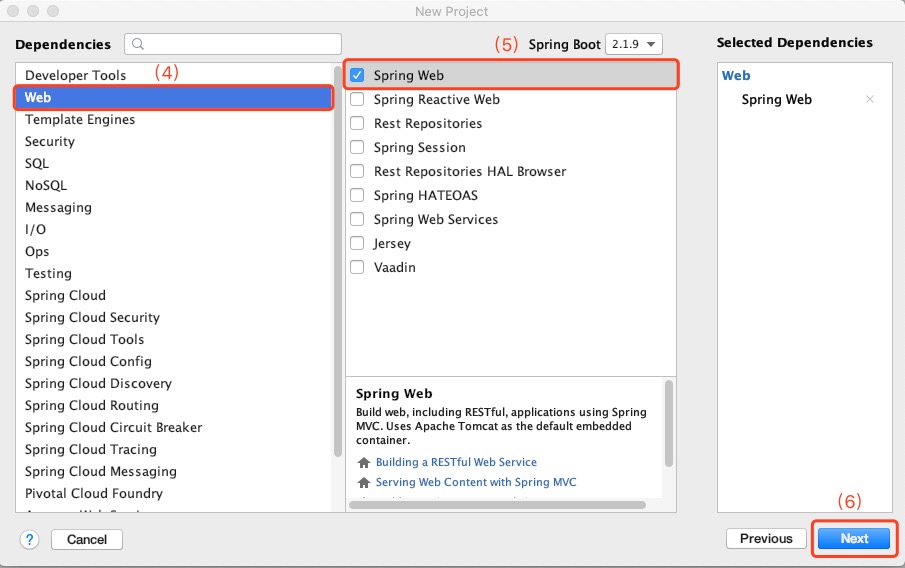Spring Boot 2.x (一):第一个 Web 应用 Hello Spring Boot 2
Spring Boot 2.x (一):第一个 Web 应用 Hello Spring Boot 2


一、开发环境
➜ ~ java -version
java version "1.8.0_144"
Java(TM) SE Runtime Environment (build 1.8.0_144-b01)
Java HotSpot(TM) 64-Bit Server VM (build 25.144-b01, mixed mode)➜ ~ mvn -version
Apache Maven 3.6.1二、Spring Boot 简介
Spring Boot 是由 Pivotal 团队提供的全新框架,其设计目的是用来简化新 Spring 应用的初始搭建以及开发过程。该框架使用了特定的方式来进行配置,从而使开发人员不再需要定义样板化的配置。通过这种方式,Spring Boot致力于在蓬勃发展的快速应用开发领域(Rapid Application Development)成为领导者。
Spring Boot 具有以下特点:
- 可以创建独立的 Spring 应用程序,并且基于 Maven 或 Gradle 插件,可以创建可执行的 JARs 和 WARs;
- 内嵌 Tomcat 或 Jetty 等 Servlet 容器;
- 提供自动配置的 “starter” 项目对象模型(POMS)以简化 Maven 配置;
- 尽可能自动配置 Spring 容器;
- 提供一些常见的功能、如监控、WEB容器,健康,安全等功能;
- 绝对没有代码生成,也不需要 XML 配置。
三、创建 Web 项目
3.1 首先启动 Idea 找到 File -> New -> Project -> Spring Initializr

3.2 选择 Next,填写项目元信息
- Group: 组织 ID,一般分为多个段,第一段为域,第二段为公司名称。域又分为 org、com 或 cn 等等,其中 org 为非营利组织,com 为商业组织。
- Artifact: 唯一标识符,一般是项目名称。

3.3 继续选择 Next,勾选项目依赖,这里选择 Web -> Spring Web

3.4 填写项目名和项目路径

3.5 最后选择 Finish
此时第一个 Web 项目就创建完成了,对应的目录结构如下:
├── HELP.md
├── chapter1.iml
├── mvnw
├── mvnw.cmd
├── pom.xml
└── src
├── main
│ ├── java
│ │ └── com
│ │ └── semlinker
│ │ └── chapter1
│ │ └── Chapter1Application.java # 项目启动类,包含main函数
│ └── resources
│ ├── application.properties # 项目主要的配置文件
│ ├── static
│ └── templates
└── test
└── java
└── com
└── semlinker
└── chapter1
└── Chapter1ApplicationTests.java此外在根目录下还存在一个 pom.xml 文件,POM(Project Object Model,项目对象模型)是 Maven 工程的基本工作单元,是一个 XML 文件,包含了项目的基本信息,用于描述项目如何构建,声明项目依赖,等等。
执行任务或目标时,Maven 会在当前目录中查找 POM。它读取 POM,获取所需的配置信息,然后执行目标。
POM 中可以指定以下配置:
- 项目依赖
- 插件
- 执行目标
- 项目构建 profile
- 项目版本
- 项目开发者列表
- 相关邮件列表信息
了解完 pom 相关的基础知识,我们来一睹它的真容。打开项目中的 pom.xml 文件,该文件的具体内容如下:
<?xml version="1.0" encoding="UTF-8"?>
<project xmlns="http://maven.apache.org/POM/4.0.0" xmlns:xsi="http://www.w3.org/2001/XMLSchema-instance"
xsi:schemaLocation="http://maven.apache.org/POM/4.0.0 https://maven.apache.org/xsd/maven-4.0.0.xsd">
<modelVersion>4.0.0</modelVersion>
<parent>
<groupId>org.springframework.boot</groupId>
<artifactId>spring-boot-starter-parent</artifactId>
<version>2.1.9.RELEASE</version>
<relativePath/> <!-- lookup parent from repository -->
</parent>
<groupId>com.semlinker</groupId>
<artifactId>chapter1</artifactId>
<version>0.0.1-SNAPSHOT</version>
<name>chapter1</name>
<description>Demo project for Spring Boot</description>
<properties>
<java.version>1.8</java.version>
</properties>
<!-- 项目依赖 -->
<dependencies>
<!-- 默认内嵌Tomcat容器 -->
<dependency>
<groupId>org.springframework.boot</groupId>
<artifactId>spring-boot-starter-web</artifactId>
</dependency>
<!-- 测试依赖包,执行mvn package的时候,该包并不会被打入,因为它的生命周期只在test之内-->
<dependency>
<groupId>org.springframework.boot</groupId>
<artifactId>spring-boot-starter-test</artifactId>
<scope>test</scope>
</dependency>
</dependencies>
<build>
<plugins>
<plugin>
<groupId>org.springframework.boot</groupId>
<artifactId>spring-boot-maven-plugin</artifactId>
</plugin>
</plugins>
</build>
</project>说了那么多,有些小伙伴估计已经按捺不住了,我们赶紧来启动一下我们的第一个 Web 应用。

在运行 Chapter1Application 应用后,我们将在控制台看到 Spring Boot 的启动信息:
. ____ _ __ _ _
/\\ / ___'_ __ _ _(_)_ __ __ _ \ \ \ \
( ( )\___ | '_ | '_| | '_ \/ _` | \ \ \ \
\\/ ___)| |_)| | | | | || (_| | ) ) ) )
' |____| .__|_| |_|_| |_\__, | / / / /
=========|_|==============|___/=/_/_/_/
:: Spring Boot :: (v2.1.9.RELEASE)
...
...
--- [main] o.s.b.w.embedded.tomcat.TomcatWebServer: Tomcat started on port(s): 8080 (http) with context path ''
--- [main] c.s.chapter1.Chapter1Application: Started Chapter1Application in 1.532 seconds (JVM running for 2.045)通过观察启动信息,我们可知 Spring Boot 默认使用 Tomcat 作为 Servlet 容器,且使用 8080 作为默认端口。小伙伴们是不是觉得入门 So easy,但当你在浏览器中访问 http://localhost:8080/ 地址,你将会看到以下不忍直视的画面:
Whitelabel Error Page
This application has no explicit mapping for /error, so you are seeing this as a fallback.
Sat Oct 12 12:16:49 CST 2019
There was an unexpected error (type=Not Found, status=404).
No message available从 This application has no explicit mapping for /error 错误信息中,可知是由于我们未设置 \ 映射信息导致的,下面我们来着手解决这个问题。要解决这个问题,我们需要新建一个 HelloController 类,在该类下定义请求映射信息,具体如下:
package com.semlinker.chapter1.controller;
import org.springframework.web.bind.annotation.RequestMapping;
import org.springframework.web.bind.annotation.RestController;
@RestController
public class HelloController {
@RequestMapping("/")
public String greet() {
return "Hello Spring boot 2.x";
}
}在完成 HelloController 类的定义之后,我们需要重新启动一下应用。当应用成功启动之后,我们再来使用浏览器来访问一下 http://localhost:8080/ 地址,如果不出意外的话,我们将在页面中看到预期的结果:
Hello Spring boot 2.x四、常见问题
4.1 端口被占用怎么办
通过前面的介绍,我们可知 Spring Boot 默认使用的端口是 8080,所以如果你们本地的 8080 端口已经被占用了,那么你将不能正常启动 Spring Boot 项目。对于这个问题,我们可以通过一个简单的方式来解决,即通过配置文件 application.properties 来修改默认的端口。
server.port=8088当修改完配置文件,重启应用的时候,在控制台可以看到以下的输出信息:
embedded.tomcat.TomcatWebServer : Tomcat initialized with port(s): 8088 (http)这就表明我们已经成功修改了 Tomcat 默认的端口。
4.2 如何进行单元测试
细心的小伙伴可能会注意到在 chapter1 项目的根目录下的 pom.xml 文件中还配置了一个依赖 —— spring-boot-starter-test:
<dependency>
<groupId>org.springframework.boot</groupId>
<artifactId>spring-boot-starter-test</artifactId>
<scope>test</scope>
</dependency>顾名思义,这个依赖就是为我们项目提供单元测试支持。
package com.semlinker.chapter1;
import org.junit.Test;
import org.junit.runner.RunWith;
import org.springframework.beans.factory.annotation.Autowired;
import org.springframework.boot.test.context.SpringBootTest;
import org.springframework.boot.test.web.client.TestRestTemplate;
import org.springframework.boot.web.server.LocalServerPort;
import org.springframework.http.ResponseEntity;
import org.springframework.test.context.junit4.SpringRunner;
import java.net.URL;
import static org.junit.Assert.assertEquals;
@RunWith(SpringRunner.class)
@SpringBootTest(webEnvironment = SpringBootTest.WebEnvironment.RANDOM_PORT)
public class Chapter1ApplicationTests {
@LocalServerPort
private int port;
@Autowired
private TestRestTemplate template;
@Test
public void testGreet() {
ResponseEntity<String> response = template.getForEntity("http://localhost:" + port,
String.class);
assertEquals(response.getBody(), "Hello Spring boot 2.x");
}
}在 Chapter1ApplicationTests 测试类中,我们通过注入 TestRestTemplate 对象,来发送 Http 请求。需要注意的是在使用 @SpringBootTest 注解时,需要设置 webEnvironment 属性,否则运行单元测试时,会抛出异常,
详细信息可以参考 spring boot test unable to inject TestRestTemplate and MockMvc 这篇文章。
为了让项目更加直观,已对项目做了以下调整: Chapter1Application -> HelloSpringBoot2Application com.semlinker.chapter1 -> com.semlinker 项目地址:https://github.com/semlinker/springstack/tree/master/hello-springboot2
